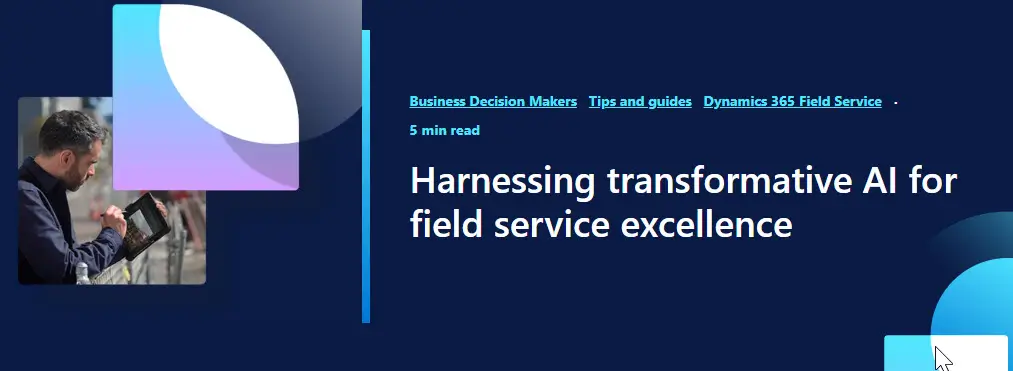Introduction: A Glimpse into the Future of Field Service
AI in Dynamics 365 Field Service: In today’s fast-paced world, efficient field service operations can be a game-changer for many industries. But the secret sauce that is taking field service to the next level is Artificial Intelligence (AI). Not only does AI streamline operations, but it also empowers businesses to offer unparalleled customer experiences. In this guide, we’ll unravel the jargon and complexities surrounding Field Service Management with AI, encompassing topics like predictive maintenance, Microsoft Dynamics 365 Field Service , AI-powered workforce management, and more.
Understanding AI in Dynamics 365 Field Service
Field service refers to any service work conducted on-site, typically involving installation, repair, or maintenance. AI in field service stands for the integration of artificial intelligence technologies to automate processes, optimize operations, and enhance service delivery. Let’s dive deeper into what this entails.
Predictive Maintenance: A Proactive Approach
Gone are the days when maintenance meant responding to failures after they happened. Predictive maintenance uses AI to foresee equipment issues before they lead to breakdowns. This is achieved by analyzing data from sensors and historical patterns to predict potential failures. By foreseeing problems, companies can plan maintenance during downtimes, thus minimizing disruptions and extending the lifespan of equipment.
Harnessing the Power of Microsoft Dynamics 365 Field Service
Microsoft Dynamics 365 Field Service is a comprehensive platform that blends CRM capabilities with field service management. It utilizes AI to offer insights and recommendations, enabling businesses to deliver smarter and more efficient service. This tool optimizes everything from resource scheduling to work order management, helping field service teams offer better and faster service.
AI-Powered Workforce Management
Managing a field workforce is no small feat. AI in workforce management means using advanced algorithms to assess team performance, allocate tasks efficiently, and ensure the right technician is dispatched for the right job. Not only does this boost productivity, but it also enhances customer satisfaction as issues are resolved swiftly and accurately.
Internet of Things (IoT) in Field Service
IoT and AI create a powerful synergy. IoT devices collect vast amounts of data from various assets and machinery. AI then processes this data, extracting actionable insights to predict failures, optimize operations, and even trigger automatic repairs. This ensures minimal human intervention, reducing errors and labor costs.
AI Chatbots: The New Face of Customer Service
AI chatbots have revolutionized how customers interact with companies. In field service, these chatbots handle inquiries, collect information, and even assist in troubleshooting simple customer issues. This ensures immediate responses, freeing human agents to tackle more complex tasks. While chatbots are excellent at handling routine queries, complex issues often require human touch.
Data-Driven Decision Making
AI’s predictive analytics capabilities mean that decision-makers have access to real-time data and insights. This empowers businesses to make informed decisions quickly, whether it involves reallocating resources or adapting to changing service demands. Data-driven decisions enhance efficiency, reduce costs, and heighten customer satisfaction.
AI in Scheduling and Dispatching
Effective scheduling and dispatching are critical components of field service. AI optimizes these processes by analyzing factors such as technician location, skill set, and equipment availability. This ensures the right technician is dispatched at the right time, reducing service times and increasing first-time fix rates.
Conclusion: Transforming Field Service with AI
AI is not merely a technological trend—it’s an essential component for modern field service management. Businesses that embrace AI can anticipate and solve problems before they occur, offer personalized customer experiences, and improve service quality and efficiency. As technology continues to evolve, so too will the capabilities of AI in the field service industry.
Frequently Asked Questions (FAQs)
Can AI chatbots handle complex customer queries?
While AI chatbots efficiently manage routine inquiries, complex queries often require human intervention for optimal resolution.
What is AI in field service?
AI in field service involves using artificial intelligence technologies to improve efficiency and service delivery in on-site service operations.
How does predictive maintenance work with AI?
AI analyzes data from sensors and historical patterns to predict equipment failures before they happen, allowing for timely maintenance.
What are the benefits of AI-powered workforce management?
AI improves task allocation, enhances productivity, and ensures that the right technician is dispatched for the right job, increasing overall efficiency.
What is Microsoft Dynamics 365 Field Service?
It is a platform combining CRM and field service management capabilities to enhance service delivery through smart insights and AI-driven recommendations.
How can AI improve customer experience in field service?
AI offers personalized service, quick responses through chatbots, and proactive maintenance, leading to superior customer experiences.
How does AI help in scheduling field technicians?
AI analyzes various factors to optimize scheduling, ensuring the right technician is sent to the right job at the right time.
#MSFTAdvocate #AbhishekDhoriya #LearnWithAbhishekDhoriya #DynamixAcademy
References & Read More:
- The Ultimate Guide to Supplier Communications Agent in Dynamics 365 Supply Chain Management
- Mastering Business Central Location Setup: A Comprehensive Guide for Beginners
- Understanding Financial Reports in Business Central: Step by Step Beginner’s Guide
- Microsoft Business Applications Launch Event 2024
- Comprehensive Guide to Setting Up Currencies in Business Central

1 thought on “Understading AI in Dynamics 365 Field Service: A Beginner’s Guide”